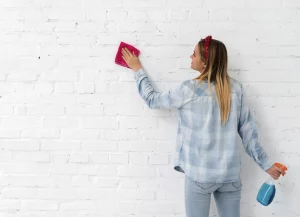
Even though walls are one of the most neglected places when it comes to regular cleaning, they do need maintenance as much as your floors, windows, etc. Depending on the type of walls you have, you may need to take a different approach to achieve the best results possible while not causing any harm at the same time.
Whenever you do your regular weekly or monthly cleaning of the house (vacuuming, dusting, etc.) you should also dust your painted walls and remove cobwebs. Make sure you do a more thorough cleaning once a month. This can include spot treatment and cleaning discolouration around door knobs and light switches. If you have any larger splatters, crayon or scuff marks, or greasy fingerprints, keep reading to find out the best way to get rid of them.
Before you attempt cleaning your painted walls, you should identify the type of paint that you have. While all types of paint can be dusted, when it comes to deep cleaning and washing the surface of the wall you should really take the paint type and requirements into consideration in order to avoid damage and further discolouration.
There are two types of interior wall paint you may have but their finishes are also important. Here are some of the most basic interior wall paints:
- Oil-based paints – Those are most often used in moist areas. This type of paint is more durable than latex paints and withstands cleaning better.
- Water-based latex paints – This is the most common indoor paint type. It is less prone to chipping and cracking, however, it is not as good at withstanding washing as oil-based paints.
Types of interior paint finishes:
- Flat or Matte – Almost chalky in appearance, with a little sheen to the surface; does not clean well; do not use strong chemicals, a lot of moisture, or extreme pressure when cleaning.
- Eggshell or Satin – Reflects light with a subtle shine; is more resilient for cleaning and is appropriate for high traffic areas; avoid using abrasive cleaners; and limit the quantity of liquid used when washing.
- Semi-gloss – Reflects light with a prominent sheen; a good choice for kitchens, bathrooms, doors, and woodwork; resists moisture, except the strongest chemicals.
- High gloss – Leaves a strong and lustrous shiny surface; the most durable finish; suitable for furniture, cabinets, and trim; cleans easily with detergent or a degreaser.
Cleaning water-based latex paint walls
- Dust the surface of the wall – Use a vacuum cleaner with a brush extension or a microfiber duster. Start at the top and work your way down.
- Mix a cleaning solution – Add 1 teaspoon of all-purpose cleaner into a bucket of water. Fill another bucket with clean water.
- Wash the wall with a soft sponge or a cloth – Dip a soft sponge or a cloth in the cleaning solution and wring it until it is not dripping but only moist. Start at the top of the wall and work in small sections. Use circular motions and do not apply too much pressure.
- Rinse the wall – Dip another soft cloth in the plain water, wring it until it is not dripping, and repeat the step above in order to remove any soapy residue.
- For stains and marks – For stubborn scuffs and smudges, dab a wet sponge in baking soda and lightly rub the affected area. The baking soda’s light abrasive impact should take care of the problem. To remove grime from painted areas surrounding doorknobs and trim work, use rubbing alcohol on a sponge.
Cleaning oil-based paint
- Dust the surface of the wall – removing dust and cobwebs will prevent them from spreading around while you are cleaning the wall.
- Mix a cleaning solution – In a bucket, combine one teaspoon of dishwashing liquid and 1/2 teaspoon distilled white vinegar per litre of warm water. Pour plain water into a second bucket for rinsing.
- Clean and rinse the wall – Dip a soft cloth or a sponge in the cleaning solution and gently scrub the wall starting at the top and working your way down. Follow by a clean cloth dipped in plain water and rinse the wall.
- For stubborn stains – Add two tablespoons of laundry borax to the cleaning solution if the walls are stained. To remove grime from semi-gloss or glossy oil paint finishes, use a melamine sponge (like Mr Clean Eraser). The abrasive action will remove all scuffs with a gentle touch.
To reduce the dirt and grime on your painted walls, follow these tips:
- Avoid smoking in the house, from tobacco and cooking to burning candles or incense; combustion soot coats walls, making them unclean faster.
- Spot cleaning walls as soon as you discover smudges or hand prints between big cleaning tasks. It will prolong the appearance of clean walls.
- Read the box of paint or ask the people who applied it for the best cleaning method, most suitable for that particular type. It will make maintenance easier and help you keep your walls bright and clean for longer.
